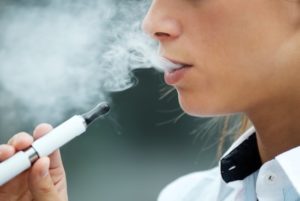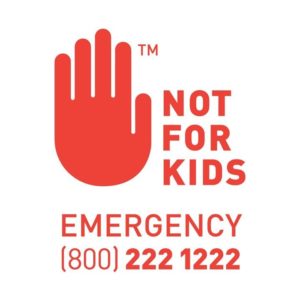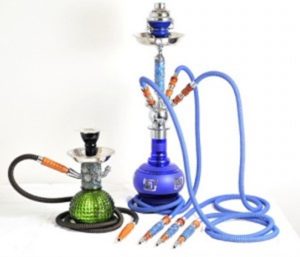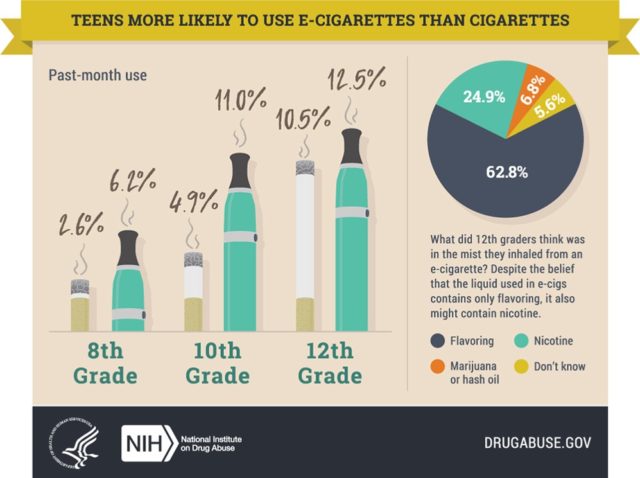
Compiled by USAG Stuttgart Public Affairs
Vaping is the act of inhaling vapor produced by any kind of electronic cigarette or personal vaporizer. Users load a liquid solution containing their drug of choice into the device. When they draw on the device, the battery heats the liquid, which is then atomized into an inhaleable vapor.
Products that look like pens or highlighters can easily be hidden. Smoke detectors won’t catch the aerosol and there is no odor. One-time use and refillable products are easily purchased in retail stores.
Vaping Devices:
Electronic cigarette: smokeless, battery operated device used to deliver nicotine with flavorings or other chemicals to the lungs.
Vaporizer pen or vape pen: a device ranging in size from a standard pen to a large cigar used to generate an inhalable vapor from a solid, semi-solid, or liquid substance.
Three components: A liquid cartridge used to produce the vapor. A heating element known as the atomizer and a rechargeable battery to power the atomizer.
Safer ≠ Safe

According to the Washington Poison Center, yes–cigarette smoke contains more than 7,000 chemicals, so vaping and secondhand vape is probably not as harmful as smoking. However, safer does not equal safe. Vape aerosols have been found to contain cancer causing formaldehyde releasing chemicals1(at high voltage) and free radicals. Also, 50 percent of e-liquids can cause severe respiratory injury, bronchitis obliterans (popcorn lung).
Children, especially those under the age of five, have been reported to the Washington Poison Center with common symptoms for e-cigarette exposure, including:
- Persistent Vomiting
- Drowsiness/Lethargy
- Eye Irritation/Pain
- Nausea
- Coughing/Choking
- Agitation/Irritability

Vaping devices, liquids and methods
Hookah: water pipes that are used to smoke specially made tobacco that come in different flavors. Even after it has been passed through water, the tobacco smoke in a hookah pipe contains high levels of cancer-causing chemicals. Smoke inhaled in a typical one-hour hookah session can equal 100 cigarettes or more according to the World health Organization.
Hash Oil and THC: tetrahydrocannabinol is the chemical responsible for most of marijuana’s psychological effects. Liquid THC is applied to a vaping device the same way that flavored nicotine liquid is. Documented effects of vaping oil, reported by Carolina’s Poison Center include:
• Seizures / Unconsciousness
• Vomiting / Nausea
• Headaches / Dizziness / Lightheadedness
• Memory Loss
Not all vape oils contain substances or compounds which are considered narcotics. The majority of vape oils only contain nicotine; however, numerous products are being marketed as containing cannabidiol, cannabidiol derivatives or THC.
Butane Hash Oil or Marijuana Waxes: A wax-like or pollen-like residue placed directly onto coil.
Dripping: a method of vaping in which the user manually applies a few drops of liquid directly to the exposed heating coil of the e-cig every so few puffs. This produces thicker clouds of vapor, gives a stronger sensation in the throat and makes flavors taste better according to the Journal of Pediatrics. Dripping generates higher heating coil temperatures than conventional use of e-cigarettes, which lead to greater emissions of a class of harmful chemicals. Some chemicals released are associated with cancer, chronic obstructive pulmonary disease. Handling liquid also exposes a person to direct skin contact with nicotine which is absorbed rapidly through human skin.
Alcohol: When you vape alcohol, it goes directly into the bloodstream. There is a rapid rush of alcohol to the brain. Rates of alcohol poising are much higher and there is no way to “detox” from it.
Teen Use
Use of e-cigarettes by middle and high school students has shown to have created a “vape culture” among today’s young people. By 2015, 16 out of 100 had used e-cigarettes according to the Centers for Disease Control and Prevention. Teens may use alternate terms for e-cigarettes such as: cartridges, carts, water pipe, vape pipe/pen, Juul. Some also connect to other electronic devices to play music and answer calls.
E-cigarettes can increase nicotine addiction among young people and have shown to increase in teens likeliness to try other tobacco products, including conventional cigarettes. One in four teens who vape say they’ve used the dripping method.
 Signs for parents to look for:
Signs for parents to look for:
- “Pens” that aren’t pens.
- New scents: the vapor can be flavored (fruit punch, bubble gum).
- Typical signs of marijuana use: red eyes, lethargic, increase cravings for snacks, confusion, anxiety, lack of focus/coordination, unusually talkative, dropping studies or usual activities, change of friends, and/or secretiveness.
- Increase of water intake. Propylene glycol attracts and holds water molecules from its environment. This can lead e-cig users to have a constant state of dry mouth.
- Some users develop a sensitivity to caffeine, and curb their caffeine intake.
- Nosebleeds. The water-holding effect of the vapor can also dry out the nasal passages.
- Containers of butane.
Vaping On-Post
The use of all cannabidiol, cannabinol derivatives, and THC infused products that may be found in vaping oils and products are prohibited for all DoD members. Substances violating the Substance Abuse Act are unlawful for service members and punishable under the Uniform Code of Military Justice. The use, possession, manufacture, distribution, and introduction of controlled substance analogues, products containing synthetic THC agonist, natural substances, or pharmaceutical compounds with the intent to induce or enable intoxication, excitement or stupefaction of the central nervous system – along with the use of chemicals not illegal to possess in order to get high instead of their intended use-also violates punitive service regulations.
School Grounds: According to the USAG Stuttgart School Liaison Office, any kind of drug, alcohol or tobacco use is not prohibited on school grounds, to include all forms of vaping. Suspension is a minimum punishment for those found doing so.
On-Post Housing and Facilities: Chapter 7 of AR 600-63, Army Health Promotion
Using tobacco products (to include cigarettes, cigars, cigarillos, smokeless tobacco and/or electronic cigarettes, inhaled tobacco, and all other tobacco products designed for human consumption) harms readiness by impairing physical fitness and by increasing illness, absenteeism, premature death, and health care costs. Readiness is enhanced by promoting the standard of a tobacco-free environment that supports abstinence from, and discourages the use of, any
tobacco product.
Tobacco use is prohibited in all Department of the Army-occupied workplaces except for designated smoking areas. Designated smoking areas must be at least 50 feet from a building. The workplace includes any area inside a building or facility over which DA has custody and control, and where work is performed by military personnel, civilians, or persons under contract to the Army.
Use of all tobacco products is prohibited in all military vehicles and aircraft, and in all official vans and buses.
Smoking is not permitted in common spaces of multiple housing areas such as family housing apartments, unaccompanied personnel housing, unaccompanied personnel housing permanent party, Army lodging, and other Army-operated hotels and recreational lodging. Common space is defined as any space within a building that is common to occupants and visitors. These areas include, but are not limited to, corridors, laundry rooms, lounges,
stairways, elevators, lobbies, storage areas, and restrooms.
The military offers a number of resources and assistance to quit smoking or kick a habit. For more information on how to quit smoking and/or smokeless tobacco products, contact the Stuttgart Health Clinic, Public/Community Health Nurse or Behavior Health counselors for adults and children at DSN: 590-2900/civ. 06371-9464-2900.
Sources: Informational briefing by Headquarters Army Materiel Command, Public Safety Statement by U.S. Marine Corps, and the Washington Poison Center.
